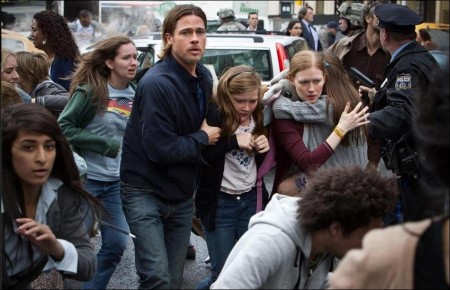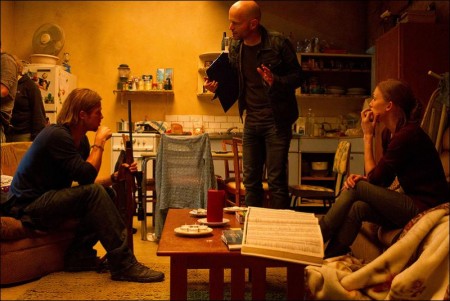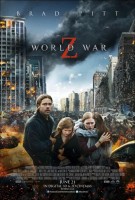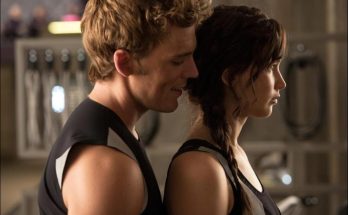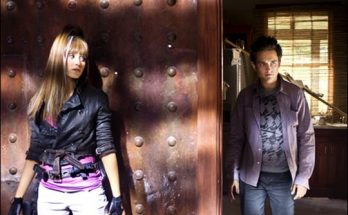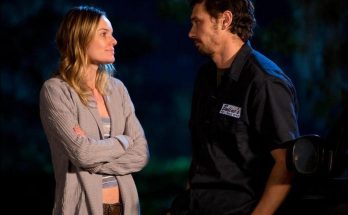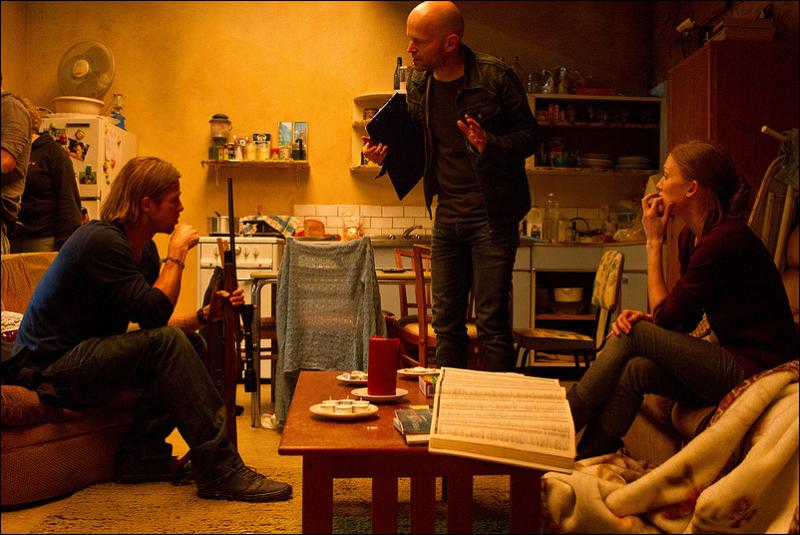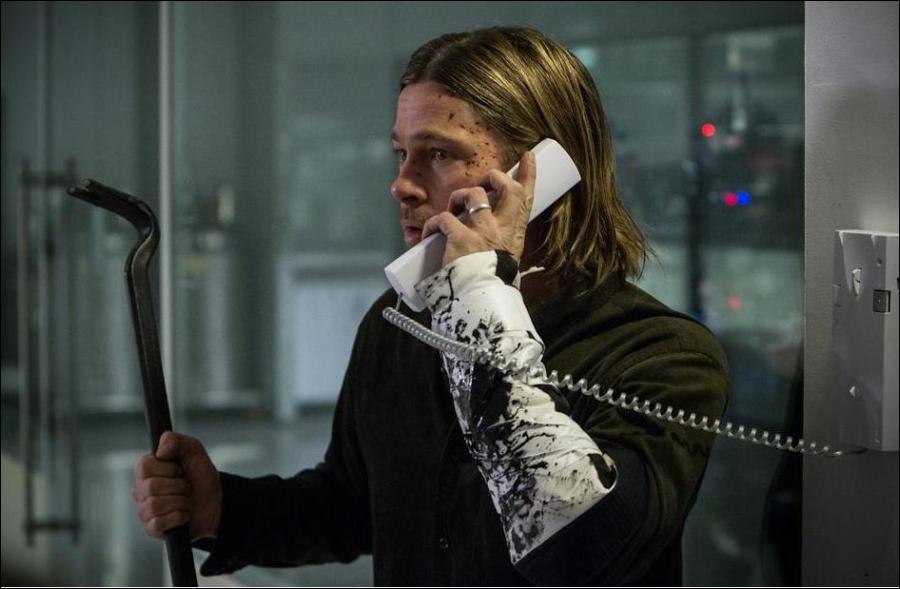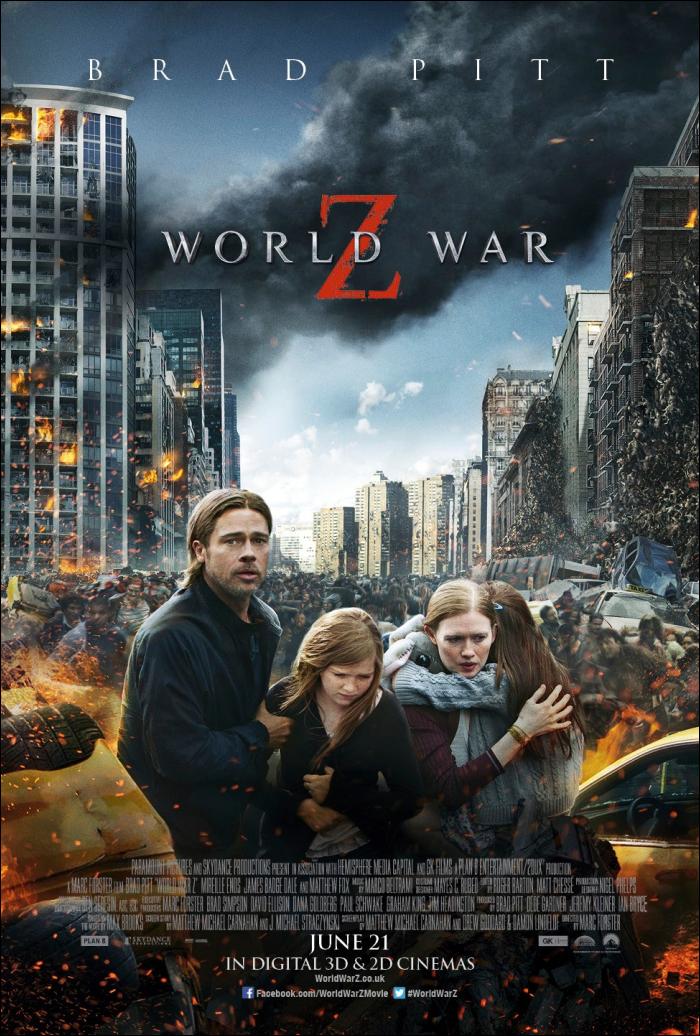Taglines: Remember Philly!
On an ordinary day, Gerry Lane and his family find their quiet drive interrupted by urban gridlock. An ex-United Nations investigator, Lane senses that this is no ordinary traffic jam. As police helicopters buzz the sky and motorcycle cops careen wildly below, the city erupts into chaos.
Something is causing hordes of people to viciously attack each other – a lethal virus that is spread through a single bite, turning healthy humans into something unrecognizable, unthinking and feral. Neighbor turns on neighbor; a helpful stranger suddenly becomes a dangerous enemy. The origins of the virus are unknown, and the number of infected grows exponentially larger each day, quickly becoming a global pandemic. As the infected overwhelm the world’s armies and rapidly topple its governments, Lane is forced to return to his dangerous former life to insure the safety of his family, leading a desperate worldwide search for the source of the epidemic and a means to stop its relentless spread.
From Page to Screen (2013)
“World War Z” began as a post apocalyptic horror novel by Max Brooks called World War Z: An Oral History of the Zombie War,written in first person, individual accounts from those who experienced it. Producers Brad Pitt, Dede Gardner, and Jeremy Kleiner read the book in galley form.
They, along with everyone at their production company, Plan B Entertainment, were captivated. “Five years ago, I knew nothing about zombies. Now, I consider myself an expert,” recalls Pitt. “Max’s book treats the zombie genre as a global pandemic, spreading much like we’ve witnessed viruses such as SARS travel.What happens when this jumps the fire break… what happens when everything we concern our days with is rendered useless?What happens when power structures and societal norms are obliterated?How will we survive?”
“It resonated with us as something that was relevant and prescient, despite being a zombie book — or maybe because of it. We didn’t know – which made it even more compelling,” Gardner recalls.
The vast scope of the story also intrigued Kleiner, who was familiar with Brooks’ work, having read his companion book/field manual, The Zombie Survival Guide. “The world scale — the intersection of zombies, politics, institutions — intrigued us and added really cool, contemporary elements unusual in the zombie genre,” says Kleiner.
However, the novel’s multi-person, testimonial approach did not necessarily lend itself to a motion picture screenplay. Ultimately, the filmmakers opted to tell the story through one protagonist as opposed to many but also endeavored to maintain the essence of the themes and plot points that initially riveted them.
Still working on the script, the team decided it was time to approach a director and turned to Marc Forster. “Marc was likeminded in that he was committed to setting the movie in the real world and maintaining the material’s verisimilitude,” Gardner recalls.
“I respect Marc as a director who has made many different kinds of films, yet with a common thread of dealing with core human issues — family, love, loss. I think he broughtthis humanistic approach to our film and I think that his openness, his not having pre-conceived notions of the limitations of zombie films, was really helpful,” adds Kleiner.
Plan B began by sending the book to Forster and like them, he was engrossed. “I thought it was a great read and it dealt with themes I am really interested in,” Forster says. “I sat down with Plan B and we started talking creatively about what we could do with the project. They had developed the script at that point, which they gave me, and that was the beginning of our discussion that eventually led to this film.”
Forster believes there is a thematic reason for their resurgence and many zombie hallmarks resonated with him and drew him to the project. “I find zombie movies fascinating in that they were popular in the 70s, at a time of uncertainty and upheaval in society. And now when we are again living in a time of change and skepticism, zombies are popular. They’re such a great metaphor — representing a sort of unconsciousness and hold a mirror to what’s happening in the world.We human beings, as a species, are unconscious to a certain degree and ultimately we have to wake up,” Forster muses.
“I don’t know anyone who doesn’t encounter zombies in the zeitgeist. I see it in advertising banners inside the New Yorker, for Zombie Survival Kits. The Occupy Wall Street movement invoked a lot of zombie mythology and there’s obviously the great success of ‘The Walking Dead’ being the highest rated show on cable television. It’s a slippery slope trying to assign metaphors to something that consider to be very popular but clearly that’s a part of it too.
The language of the zombie world is more easily understood today, I think, because of everything that’s currently going on. People are tied to their screens and their monitors and their headphones – in the most basic sense, they do walk around like zombies by not interacting with other human beings. Also, at least for me, the world feels like a tenuous place…it feels unstable. It feels like there are big waves of emotion and behavior that are sweeping over us and it’s happening more and more quickly. But it does have roots in a historical love for the genre. For me, ‘World War Z’ is intense and real and fun…also non-stop, epic, scary and, I hope, ultimately satisfying,” Gardner says.
Indeed, part of the initial appeal of the project for Pitt was the heart-pounding action and race against time aspects of the story. “Those zombies are scary as hell and the movie, I believe, works on numerous levels,” says Pitt.”But primarily it’s complete summer fun and, frankly, something I wanted to do for my sons to enjoy.”
To that end, Forster is reluctant to categorize “World War Z” solely as a “zombie movie.” “It’s not just about zombies, it’s about a global apocalypse that happens to be spread by zombies,” Forster says.
“There are a lot of parallels to what we’re living through, culturally, that lend themselves to a ‘zombie movie,’ but the great thing about Max’s book is that he set it in a realistic time frame and within a reality-based framework. That’s what really intrigued me — I wanted to create a movie that feels real, so audiences feel like this could happen, this minute, to any one of us. The general premise is that anything can happen, in any kind of scenario, on any given day. No one is spared, everyone is susceptible. That’s the plotline in the movie but it’s also real life,” Forster says.
Around the World (2013)
In keeping with Gerry Lane’s transcontinental hunt for the cure to the spreading pandemic, “World War Z” filmed in far-flung locales, on land and often in the sea.
“First of all it’s called ‘World War Z’ so it was critical that we represent the globe. I think the planet is evident to a greater number of people than ever before — you can click a button and see what’s going on virtually anywhere. So it’s harder and harder to fake that. Audiences are smart, they know what different cities around the world look like and there is a point where you can’t engage in trickery nor do I think you should. I think movies benefit from different locales and different cultures and settings and different moods and I think that comes across on the screen,” Gardner says.
“World War Z” opens in Philadelphia as full-scale zombie pandemonium ensues. Glasgow doubled for Philly and although they are literally worlds apart, the cities share similar architecture, some of which was augmented during post-production. To further transform the Scottish city, the production replaced native signs, traffic signals and cars with their American counterparts. Also, Glasgow offered an ideal layout for showing maximum mayhem.
“The city is arranged in a square which gave us more opportunity to see the havoc and panic when the zombies invade the city,” says location manager Michael Harm. Glasgow was also particularly hospitable to the hundreds of extras and personnel required to approximate the start of the pandemic.
“When we were on the smaller streets in the beginning of the sequence, we had over 200 people to make the streets look full. As we moved into the square for the mayhem scenes, we bumped it up to 700 people. But what was really lucky was there was an old Bank of Scotland building that was completely gutted. That offered about 50,000 square feet where the background artists could stay in between shots. And we used its four floors for make-up, wardrobe and catering,” Harm says.
Veteran second unit director Simon Crane orchestrated much of the “World War Z” mayhem. “When we see the zombies for the first time, in Philadelphia, it goes from calm to 100% panic and action very quickly and Glasgow worked beautifully. Marc had a real passion for conveying the huge scale of the devastation and we tried to do that practically, in-camera, as much as possible. We approached the zombie attack like a pack of rabid dogs, running and taking people down. We were trying to bring across that fear and violence,” Crane says.
To accomplish this required carefully choreographed stunt work that began with a pre-visualized look at the action in the computer and culminated with, among other things, the sacrifice of several vehicles…
“We crashed over 150 different cars. We crashed the garbage truck and slammed Brad’s Volvo into an ambulance and various other things. It was big scale. At least 80% of the vehicles were written off,” Crane says. “Glasgow was great. We shut down blocks and blocks for controlled car crashes outside the main buildings. It was fantastic.”
Gardner notes that up until the arrival of the ‘World War Z’ production, Glasgow had not experienced the temporary influx of the army of people that populate a big, complicated movie — and, she says, the city could not have been more welcoming or accommodating.
“Glasgow was quite an operation. Even though they had not hosted a lot of big films, there was an unbelievable enthusiasm on the part of the city to not only have us but to try and make our jobs easier. The reception was just astonishing. To shoot the big opening zombie attack sequence, they shut down the main square of the city for us for over two weeks. And people rolled with it. They posted signs in their windows welcoming us. It was really terrific,” Gardner recalls.
Often the huge amount of extras and the associated personnel required to turn them into zombies became its own logistical circus. “There were many, many thousands of extra man days on the film. We had big crowd scenes in Malta, playing for Jerusalem. There were big crowd scenes in Glasgow for Philadelphia. The airplane sequence had roughly 150 extras to fill the interior of the aircraft for five days of photography. And those scenes are even further complicated, because there were heavy zombie presences.
That involves giant numbers of hair, make-up and wardrobe staff to achieve the look of what you’re trying to get. If you have 500 extras that need to look a certain way, that’s an awful lot of people required to get them ready. We were shooting one day with the full extra count and I remember coming on to the set and you literally couldn’t move because of the size of the crew that was there to get everyone ready. And then a couple hours later we sent the zombies away for a little break as we were going to do something else just with Brad and a few other people and it was like the set became barren. It was hilarious,” says producer Ian Bryce.
In keeping with the overall mantra of authenticity, the filmmaking team endeavored to ground the adrenalin-spiking zombie anarchy in reality. Gerry Lane is not a superhero but rather an astute, quick witted, hyper-perceptive man. Crane had worked with Pitt several times before and they had a shorthand, in terms of how to accomplish the complicated action scenes.
“Brad had huge input into the strategy of how we would stage all the action and we always tried to keep it as real as possible. He’s a former U.N. worker, not a fighter. He’s a real person, a normal, everyday guy. So we tried to make everything as believable as possible. He’s very good at the action stuff and wanted to be as involved as possible, which of course also helped,” Crane says.
The Lane family finds temporary safety on an enormous aircraft carrier and, in fact, the British Navy vessel the Argus stood in for the American ship. Filming the arrival sequence was quite a feat, featuring actual helicopters, 500 extras, dozens of military vehicles and of course the huge, powerful and elegant aircraft carrier itself.
“It was great to work on a real aircraft carrier instead of on stage. The emotional intensity was so much more. It offered great scale and authenticity, which is what you want for this film, because on many levels, it is a war film. The world is at war with the zombies,” Forster says.
World War Z
Directed by: Marc Forster
Starring: Brad Pitt, Mireille Enos, Daniella Kertesz, James Badge Dale, Matthew Fox, David Morse, Ludi Becken
Screenplay by: Matthew Michael Carnahan, Drew Goddard
Production Design by: Nigel Phelps
Cinematography by: Ben Seresin
Film Editing by: Roger Barton, Matt Chesse
Costume Design by: Mayes C. Rubeo
Set Decoration by: Jennifer Williams
Music by: Marco Beltrami
MPAA Rating: PG-13 for intense frightening zombie sequences, violence and disturbing images.
Studio: Paramount Pictures
Release Date: June 21, 2013
Visits: 85
